Galileo 4π: Our sphere will transform today’s flat world
Today’s leading radiation therapy systems only move in a two-dimensional plane, the flat circle. Galileo 4π from Celestial Oncology puts patients at the center of a sphere, delivering radiation in optimized paths from an infinite range of possible angles, for a revolutionary transformation of radiotherapy.
Today’s flat world
The trajectory of radiation therapy has been flat for 50 years, limited by movement in a flat 360º arc around the patient. Improvements have been incremental.


Galileo 4π sphere
Galileo 4π delivers radiation from unlimited angles in a full sphere around the patient, a transformative breakthrough optimized by advanced treatment plan software.
Revolutionary algorithms pick the right beam path from infinite options
Celestial Oncology’s Galileo 4π takes radiation therapy into an entirely new dimension with the first robotic system that can deliver radiation from all angles to a tumor, ”as many angles as stars in the sky,” applying revolutionary algorithms to automatically select the right beam paths out of thousands of possible candidates. The Galileo 4π accomplishes this utilizing proprietary algorithms derived from discoveries in advanced mathematics.
The world’s smallest medical linac enables omnidirectional movement.
The current standard in radiation therapy has been constrained by the bulk and weight of the beam source, the linac. At the heart of our breakthrough is a novel high-output mini-linac small enough to be mounted on a flexible arm, free to deliver radiation at correct doses in an unlimited range of non-coplanar angles.

Improvements in dose distribution that were never thought possible
Comparisons of 4π treatment plans with traditional treatment plans have demonstrated significant improvements in dose distribution. By spreading the dose around a sphere, we can escalate dosage to tumors while exponentially minimizing toxicity and damage to healthy tissue even with repeat treatments. 1-12
In order to treat a locally advanced lung tumor, the standard method spills high dose to a large surrounding normal tissue volume while our Galileo 4π effectively reduces the high dose spillage to allow a greater dose to be safely delivered to the tumor.
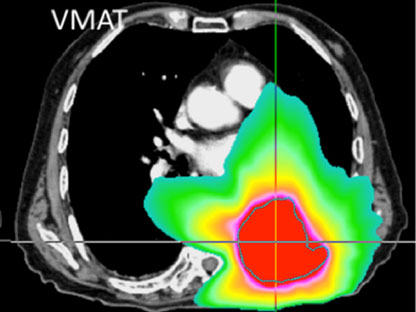
Traditional
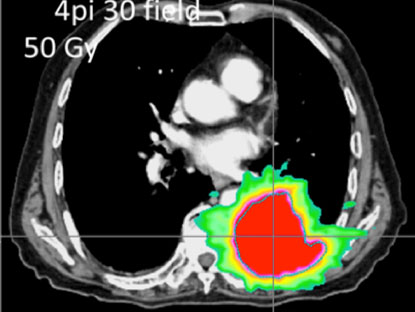
Galileo 4π 1
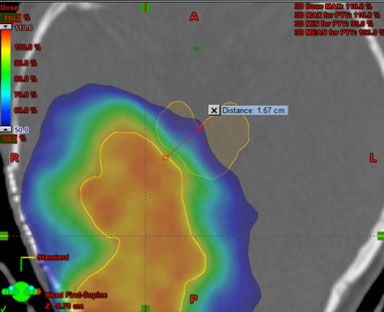
Traditional
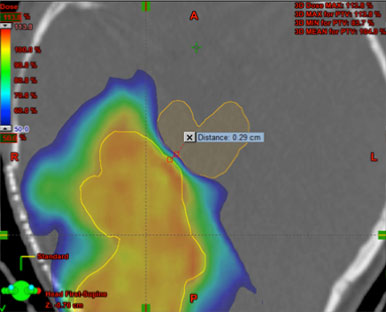
Galileo 4π 5
Compared with the standard method, our Galileo 4π is able to reduce collateral dose to the brainstem.
This image set shows marked improvement in the collateral dose to the normal healthy tissue surround the pancreatic tumor.
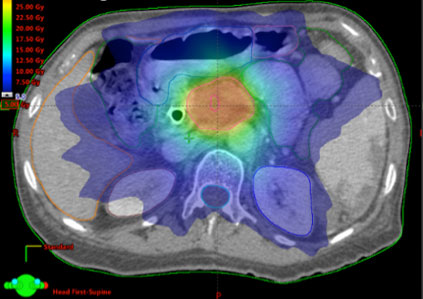
Traditional
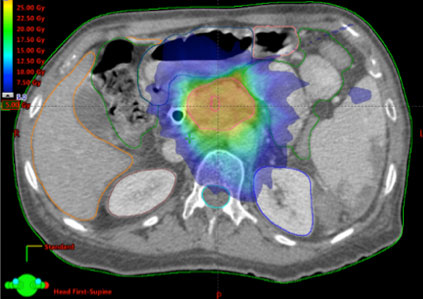
Galileo 4π (unpublished data)
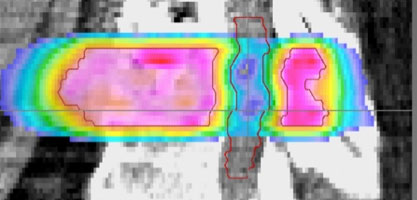
Traditional
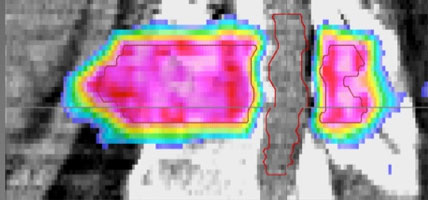
Galileo 4π (unpublished data)
Galileo 4π allows a greater, focused dose for spine SBRT.
Integrated hardware and software: high quality treatment plans and fast delivery made easy
Our hardware enables access to thousands of potential beam angles. Our integrated treatment plan software selects the angles for optimal dosimetry. Beam movement is automated. Less need to reposition the patient during treatment. Celestial Oncology’s integrated system offers a fast, easier path to better expected outcomes compared to the current standard. 13-14
Develop quality treatment plans in less time, with less trial and error, utilizing our intuitive tools that simplify real-time collaboration between physicians and dosimetrists. Change plans in 10 minutes. Treat more patients per day. Improve workflow. Simplify training. Clinicians have more options, less work.
AI, machine learning and simple tools take treatment plans to a new level
Galileo 4π solves a key complaint: the time it takes to compute, rework, review and finally produce a good treatment plan. Powered by AI, our system not only generates optimal treatment plans automatically. It “learns” physician preferences. It allows top institutions to create plan templates that can be shared, for a collective transfer of knowledge upgrading the quality of care worldwide.
A new global standard to replace legacy systems
Radiation oncologists, medical physicists and dosimetrists will no longer need to settle for the drawbacks of the accepted status quo. Galileo 4π from Celestial Oncology offers to set a new gold standard for radiation therapy, replacing the legacy systems used globally today.

High quality dose distribution
4π radiation delivery along precise beam paths selected via novel algorithms from thousands of possible angles. Improved dose distribution (conformality) with significantly reduced exposure to skin/healthy tissue1-12. Accuracy with no guesswork. Better physics. Deeper penetration with lower energy (6MV) compared to the standard.

Versatility
Improves on familiar methods while opening the way to more sophisticated non-co-planar and dynamic techniques. Proprietary algorithms upgrade conformality on conventional VMAT and IMRT. Software produces two 4π plans: 4π static beam IMRT and dynamic 4π VMAT. Choose your preference.

AI advantages
Planning system learns from oncologist in real-time and automatically generates (and continuously improves) treatment plans. Flexibility: individualization or standardization. Power of AI and machine learning amplified by networking of Galileo 4π systems among institutions will encourage superior treatment plan standards.

Delivery simplicity
Simplicity of operation reduces need for training dosimetrists in complex algorithms and processes. Consistent high quality treatment plans achieved easily. Interactive tools for fast modification of plans. Omnidirectional beam eliminates need to move patient manually – simpler for patient and clinician.

Speed & flexibility
Fast throughput facilitates treatment of more patients in a day. No need to reposition the patient after registration. Efficient workflow for tumors large and small throughout body. Dosimetrically superior plans in a single arc. Compact size yet dose rates comparable to current state of the art systems. Flexibility of varying linac-to-patient distance maximizes dose delivery efficiency.

Modularity
Compact system has small footprint; easy to transport and install. Contrasts with typical existing systems requiring bigger rooms, construction crane, re-enforcement of floors. Independent imaging and treatment robots enable simultaneous imaging and treatment with real-time target monitoring.
Multiple clinical studies completed
Clinical studies utilizing our full complement of non-coplanar beam angles, optimized by our software, have been conducted starting in 2012. Results: significant improvements in a wide range of cancer sites: brain, liver, lung, prostate, head and neck, breast. 1-12
Lead the revolution
Be part of the team poised to fundamentally transform the future of radiotherapy. Celestial Oncology, a spinoff of UCLA research, has received Series A funding and is developing the Galileo 4π final prototype to obtain 510(k) clearance in the near future.

1. Dong et al. IJROPB 2013, 2. Dong et al. IJROPB 2013, 3. Dong et al. PRO, 2014, 4. Rwigema et al. IJROPB 2015, 5. Yu et al. IJROPB 2018, 6. Dong et al. Med. Phys. 2014, 7. Nguyen et al. Med. Phys. 2014, 8. Yu et al. Med. Phys. 2016, 9. O’Connor et al. PMB 2018, 10. Nguyen et al. Radiat. Onco. 2015, 11. Woods et al. ARO 2016, 12. Tran et al. Radiat. Onco. 2017, 13. Lyu et al. PMB 2018, 14. Lyu et al. PMB 2020



